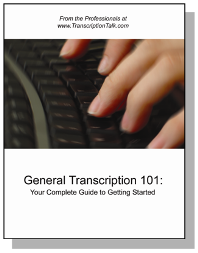First published 5/22/08
Probably the first question I am asked when people find out I work from home as a transcriptionist is, "How much does something like that pay?" This can be a difficult question to answer because there are many variables to take into account.
First you need to look at whether you want to work part time or full time. If the answer is full time, you will need to determine if what you are envisioning is full time in terms of hours or full time in terms of the level of income that you may currently have. Due to the sometimes seasonal nature of transcription, your income can vary widely from week to week. Because of the fluctuations in workflow, you may find it useful to have more than one contract that you work with. In fact, most transcriptionists would actually consider it a must to have more than one.
Companies determine the rate for a file in several different ways. Some pay by the audio hour, some by the line, some by the page, and still others by the actual work hour. For this very reason, I personally find it more useful to set my weekly goals for income at a certain dollar amount, rather than a number of audio hours, because you can't be sure how much a file will pay until it is completed in many cases.
Starting out you will probably be much slower than the average transcriptionist that has been doing this for a while. You have to be very committed to making it work, or you'll be setting yourself up for failure. However, if you're willing to put in long and sometimes crazy hours, eventually you will be rewarded with higher-paying contracts that will allow you to make more money in less time, and you'll figure out ways to increase your productivity along the way. The important thing to remember is that your income is only limited by the amount of effort that you put into furthering your skills.
One of the best pieces of advice I received when I first started in transcription was to stick with it for at least a month, taking work regularly before making the final decision as to whether it was something I really wanted to do. Mandi and I both started at the same time, and there were many nights when we chatted about how hard it was and that maybe we should give it up. But then one of us would remind the other that we should just stick with it a little longer.
We have a good laugh when we look back on those days now. Thirty minutes of audio was a daunting task back then, and now we regularly have two to three hours of audio to complete daily. As a point of reference, industry standards state that 60 minutes of audio should take approximately 4 hours to complete. The time it takes you to complete an hour of audio is known as the "turn around time" or TAT, so this would be a 4:1 TAT. However, we've found that by creating macros and using programs such as ShortKeys, we can easily achieve TATs in the range of 3:1 or even 2.5:1, which obviously would increase our income exponentially, even if our per audio hour rate remained the same.
Now, you're probably looking for cold, hard figures at this point. Most polls I've seen would lead me to believe that an average transcriptionist working full time can easily pull in about $30,000 to $40,000. However, if you're willing to make the extra effort to better your skills, the potential is much greater. I've managed to increase my income substantially year over year since I started even while adding two more children to my family. Part-time income probably averages around $10,000 to $15,000, but it's a hard one to pin down as the definition of part time can vary so widely.
The moral of all of this is that this is an industry in which hard work really pays off, which is very satisfying.
Sunday, October 5, 2008
Play It Again – Getting Started, Realistic Income Expectations
Posted by Mandi @ Life Your Way at 5:05 AM
Labels: play it again
Subscribe to:
Post Comments (Atom)









































0 Comments:
Post a Comment